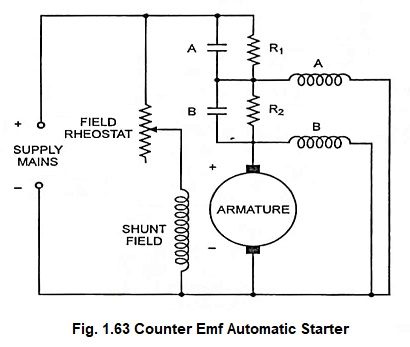Counter Emf Automatic Starter – Working Principle and its Drawbacks:
This type of starter depends upon the build up of the back or counter emf to operate the contactors (a heavy duty relay designed to open or close an electrical power circuit), which in turn causes the starting resistors to be shorted. The connections of a counter emf automatic starter are shown in Fig. 1.63.
Working Principle:
When the motor is switched on, the counter emf developed by the motor is zero and the voltage across contactor coil A or B is insufficient to energize the relays. Consequently the contactors A and B are normally open and, therefore, starting resistances R1 and R2 are in series with the armature. As the motor picks up speed and builds up a counter emf the voltage across coils A and B increases until the operating voltage of coil A is reached. Contactor A is then energized, closing the normally open contact A, shorting out the starting resistor R1.
The motor continues to pick up speed building up the counter emf until the operating voltage of coil B is reached. Contactor B is energized, closing normally open contactor B, which in turn shorts out the starting resistor R2 and places the armature directly across the supply mains.
Disadvantages:
The drawback of counter emf automatic starter is that if the motor fails to start, the counter emf remains zero, the voltage sensitive relays cannot operate and so the starting resistances may burn out. Such occurrences can, however, be avoided by using definite time-limit starters.
